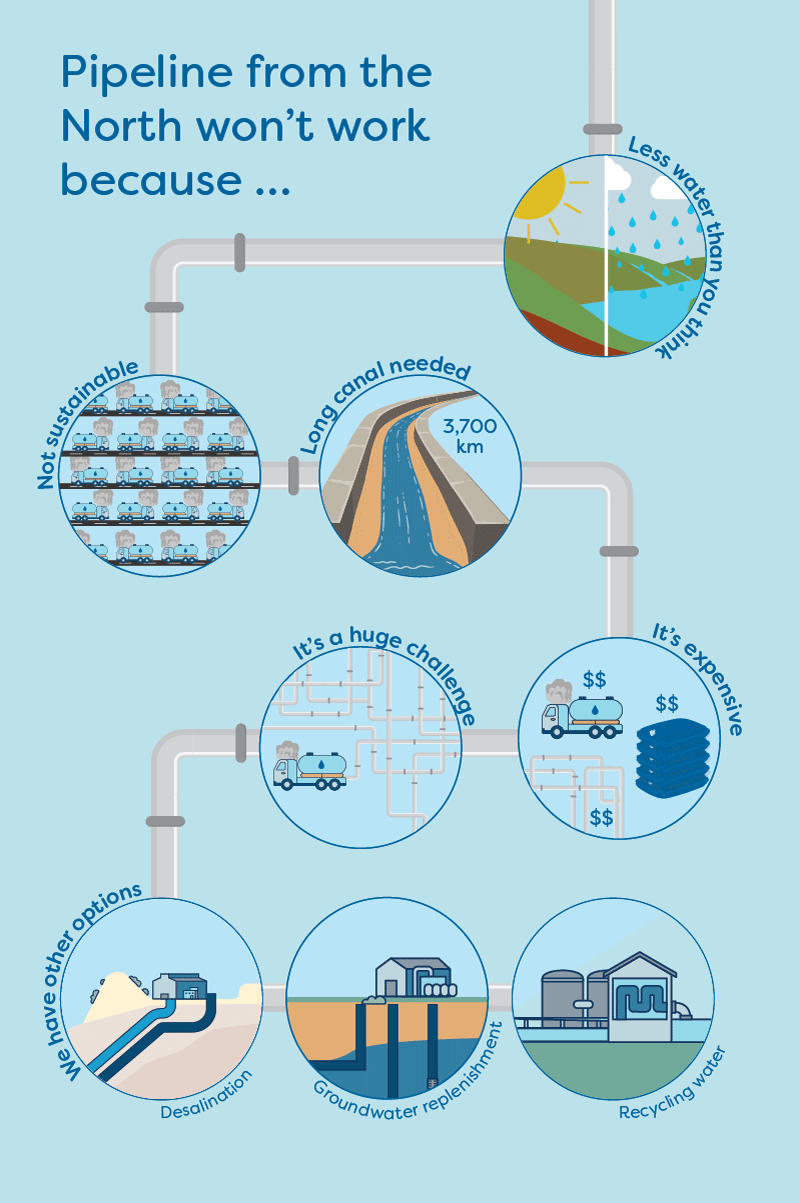If you’ve ever looked at the glistening waters of Lake Argyle or the Ord River and thought, ‘Why don’t we build a water pipeline to bring that down to Perth?’
The idea of a water pipeline from the Ord River to Perth sounds simple and promising. But when experts studied it, they found it’s not a feasible and practical solution.
Let’s explore why.

It's just too expensive
In 2006, the WA Government asked independent experts to look into the idea. They looked at various ways to transport water from the Kimberley to Perth. This included pipelines, canals, tankers and even large water bags.
Here’s what they found:
- Using super tankers is the cheapest option, but it would still cost $6.70 per kilolitre. That’s five times higher than what it currently costs us to produce a kilolitre of water through desalination.
- A pipeline would double the average household water bill, from about $304 to over $610 a year.
- Even with future technology, the cost of transporting water from the Kimberley would need to drop by 80% to be competitive and that’s not realistic.
So while it’s technically possible, the study showed it’s just too expensive. It’s also important to know that these numbers are based on a study done almost 20 years ago.
We haven’t done a full update since then. The last estimate, done in 2015, looked at moving 100 billion litres of water per year (not 200) and used 2015 prices:
Capital cost: $17 billion
Operating cost: $13.05 per kilolitre
These costs haven’t been updated to today’s dollars yet.
There’s not as much available water as it may seem
The Ord River and Lake Argyle may look full, but the Kimberley region has a wet and dry cycle:
- In the wet season, rivers flow and rain is heavy.
- In the dry season, rivers may stop flowing. Evaporation is high, so more water vanishes than what falls.
Most of the water is already being used:
- for hydro power
- for farming in the Ord River Irrigation Area
- to protect the environment
Now, with more land being opened up for farming and expansion into the Northern Territory, all available water has already been fully allocated.
The study also considered using the Fitzroy River. However, to ensure reliability, a dam or large storage would be required. Even so, any dam development would face strict rules. It could also bring serious environmental and cultural risks.
So even if we built a pipeline, it wouldn’t be able to deliver enough water to meet Perth’s water needs. Right now, Perth uses around 350 billion litres of water every year and the Kimberley’s available water just isn’t enough to reliably supply that amount.
Did you know?
Some people wonder if we could just make it rain more often to solve our water challenges. That’s the idea behind cloud seeding. A technique that tries to increase rainfall by adding particles to clouds.
But after years of research, the CSIRO found that cloud seeding is unlikely to be effective in much of Australia. Our climate, geography and the types of clouds we get just don’t make it a reliable option for increasing water supply.
Learn more
It could harm the environment
The study found that:
- A pipeline would release 0.6 million tonnes of carbon dioxide every year.
- Tankers would release even more up to 2 million tonnes.
- A canal would need to take in double the water because of leaks and evaporation. It could lose more than 200 billion litres each year.
- The canal would be 3,700 km long and would have to cross many rivers and floodplains. These areas often flood during heavy rain, so the canal could be damaged or flooded almost every year. The canal would also go through the lands of many Traditional Owner groups and could affect important cultural and heritage sites. Because of this, and the environmental risks, it’s just not a realistic option today.
Environmental risks were high across all options.
Technically, it’s a huge challenge
Two pipeline routes were studied:
- A direct route from the Fitzroy River to Perth (1900 km long, lifting water 700 metres)
- An indirect route via Kalgoorlie (2400 km)
The direct route was cheaper, but still incredibly complex. The canal option was even longer at 3700 kms and would cut across 330 square kilometres of land.
The ocean transport option (using tankers or giant water bags) had fewer land impacts, but:
- The water bags would need to be 15–20 times larger than anything used before.
- The greenhouse gas emissions were the highest of all options.
- The idea was still untested at this scale.
We have smarter safer options
Instead of building a pipeline, we’re focussing on:
- desalination
- groundwater replenishment
- recycling water
- protecting our existing water sources
These solutions are more reliable, better for the environment and already working.
It is also important to note that while this study was conducted in 2006, some people might think that new technology could make it possible now. However, the main challenges remains the same, so it’s still not considered a practical solution today.
Want to learn more?
Be waterwise
Big ideas like pipelines and tankers attract attention. But the real power is in the small choices we make daily. By being waterwise, we can all help protect Perth’s water future. Applying waterwise tips in the home, using water-efficient appliances, fixing leaks and choosing native plants can really help. Together, we can lower demand and keep our water supply strong for future generations.
Learn more
